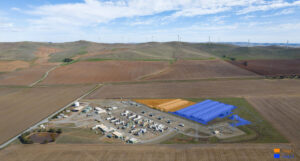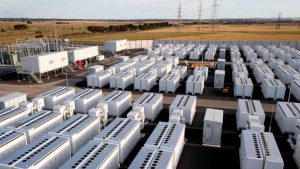Origin Energy has revealed plans to install a 4MW/4MWh battery at its rarely used Mt Stuart peaking plant near Townsville in Queensland, for use in starting up the power station in times of electricity outages, and to support the roll-out of renewables in the region.
The LG Chem lithium-ion battery will be supplied and installed at the 414MW power station – which is usually only switched on at times of peak prices, and often uses jet fuel – as part of an agreement between Origin and a Korean consortium led by Bosung Powertec.
Origin says the battery will help in the case of major grid outages, and the integration of renewables, but it could also be a sign that it recognises that battery storage will be a cheaper and more efficient response to surges in demand than the traditional peaking power stations like Mt Stuart.
A plant like Mt Stuart operates rarely but cashes in when it does. In 2016/17, Mt Stuart operated at just 2 per cent capacity, but reaped an average $741/MWh when it did. That’s about 10 times the average price of electricity in Queensland this year. Batteries, and for that matter other technologies like demand response, are a lot cheaper.
Origin says the installation of the battery is the first time a grid-connected battery in Australia’s National Electricity Market to be co-located with an open cycle gas power plant – although RE notes that an 11MWh Kokam battery was installed at Alinta’s 180MW Newman gas-fired power station, in WA’s Pilbara region, in April.
As Giles Parkinson reported here, that Kokam battery is designed to allow one of the gas generators at the Alinta facility to be switched off, at which point it will jump in to provide inertia, frequency, voltage and operating protections.
Elsewhere, however, the majority of grid battery projects of this kind have been, or are being, paired with solar or wind farms, or in the case of one Victoria battery, as a separate grid support unit..
Australia currently boasts the world’s largest grid-connected battery installation – the Hornsdale Power Reserve next to the SA Hornsdale Wind Farm, comprising 100MW/129MWh of Tesla Powerpack batteries.
That battery, as Bruce Mountain and Steven Parker write here, has captured the attention of energy analysts, policy makers, and market operators and investors, for its success, so far, in the wholesale and FCAS (frequency control ancillary services) markets.
And just over a month ago, 4MWh of Tesla Powerpack batteries arrived on site in north Queensland, ready to be installed at what will be the world’s first grid-connected project combining large scale wind, solar and battery storage – the Kennedy Energy Hub.
Origin is not the first utility to turn to grid-scale battery storage, either. In Western Australia, Horizon Power deployed that state’s first multi-function utility-grade battery in Carnarvon last year.
That 2MWh facility will be used to optimise spinning reserve and is expected to save hundreds of thousands in maintenance and fuel costs in the process.
For Origin, however, the battery at Mt Stuart – which is expected to be installed and commissioning in May 2019 – is expected serve multiple purposes, including the delivery of important learnings in the transition to renewables.
“This will be the first time in Australia that a grid scale battery has been connected to an open cycle gas turbine system and will not only create efficiencies, but enable a reliable start up in the event of a large scale power outage,” said Origin executive general manager of energy supply and operations, Greg Jarvis.
“Having a battery of this size means we’re able to store the energy needed to start the power station without the aid of the electricity from the transmission network should a loss of power occur due to an event like a cyclone.
“The battery will also help drive down emissions and support renewable projects like the recently commissioned Clare Solar Farm, by storing solar generation during the day and dispatching at times of peak demand after the sun has set.
“Our transition to renewables and shift to decentralised generation requires an ongoing focus on ensuring our customers have reliable and affordable energy and we’ll be looking closely at the battery’s performance to see how larger versions might be deployed elsewhere across our generation portfolio,” Jarvis said.
Bosung Powertec – a South Korea-based manufacturer and distributor of power supply materials – said in a statement that it hoped the deal with Origin would help showcase the country’s emerging battery technology sector.
“Bosung Powertec recognises Origin as a leading Australian energy provider that is actively exploring new and emerging technologies that support their transitioning electricity market,” said CEO Jae Hwang Lim.
“We hope to demonstrate how our battery technology supports Origin’s operations and are sure that this project will be a start for a successful cooperation in the Australian market.”
South Korea is home to some of the world’s biggest lithium-ion battery makers, including LG Chem and the aforementioned Kokam.
RE was not able to find much information about Bosung Powertec’s recent battery storage projects, but has learned that the South Korean consortium – which includes Plaspo (inverter) and Blue Sigma (energy management systems) – did not tender for the Mt Stuart job.










